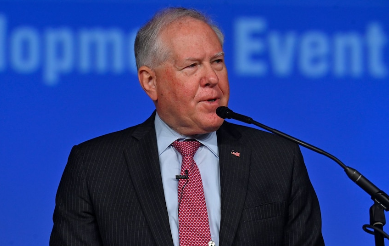
When U.S. Air Force Secretary Frank Kendall came into office in mid-2021, one of his first steps was to review the Advanced Battle Management System (ABMS) program and broader command and control modernization efforts.
They had grown broad and disjointed and needed to be focused on fielding specific operational systems.
Now, more than a year later, this effort has shown that the problem is even bigger. Kendall, speaking Sept. 19 at the Air Force Association’s Air, Space and Cyber Conference, said he is overhauling the service’s command, control, communications and battle management (C3BM) modernization under a new program executive to ensure it is focused and will not fail.
“We had not appreciated the scope of the effort needed to modernize [C3BM] in a [Joint All Domain Command and Control] context,” Kendall says. “Our efforts to date have not been adequately focused nor have they been adequately integrated.”
Kendall has appointed Brig. Gen. Luke Cropsey to be the integrated program executive officer in this area, reporting to the service’s acquisition boss and charged with technical authority over architecture and system design, system engineering configuration management and interface control. The Department of the Air Force will hold quarterly reviews of progress to ensure it stays on track.
“The [Department of the Air Force] is a large ship that turns slowly, but to use a sailing expression, the helm is hard over,” Kendall says. “We’ve identified the change we need to accelerate to avoid losing. Now we have to resource that change and execute the plan to make it happen.”
Progressing on ABMS has been one of Kendall’s operational imperatives—one of seven key topics the service must progress on, with much of the plans expected to be outlined in the fiscal 2024 budget request—and this work so far has shown that centralized leadership on the technical side is necessary. There are several disjointed efforts within the Air Force and the broader Pentagon that have not been focused enough, Kendall says.
In the history of all Pentagon programs, Kendall says he has seen that the most unsuccessful ones are battle management because they are too broad and require interaction across multiple partners who “may not want to change to accommodate each other,” he says. Broad ambitions without enough collaboration causes cost and performance problems and schedule issues.
“I don’t want that to happen here, and the way to avoid that is to put somebody in charge who has the technical authority, and they way we’re organized right now with separate [program executive officers] and program managers, we don’t have a single technical authority that covers across our C3 battle management systems,” Kendall says.
As this work is happening, the Air Force has awarded contracts to L3Harris, Leidos, Northrop Grumman, Raytheon Technologies and SAIC for a newly launched ABMS Digital Infrastructure Consortium. These companies will perform system engineering for the digital backbone of ABMS, which aims to quickly connect sensors with other weapons systems.
